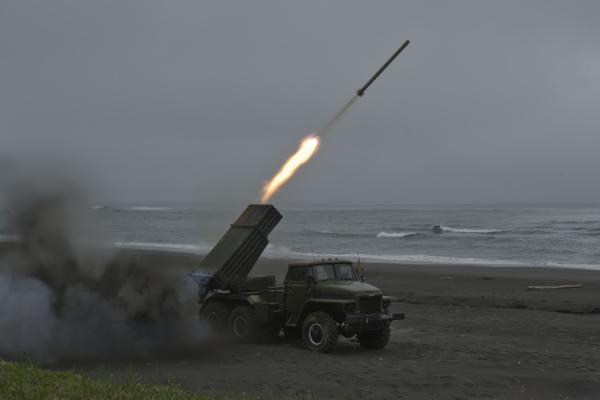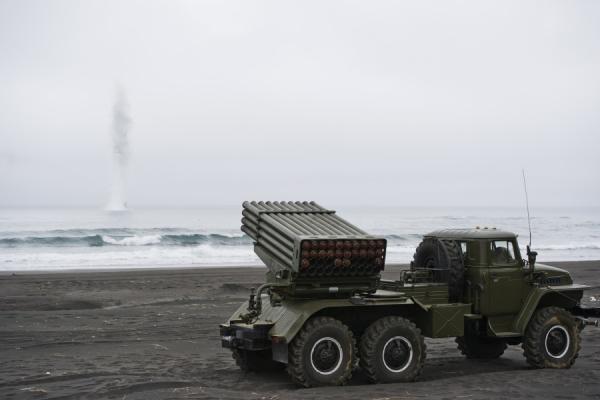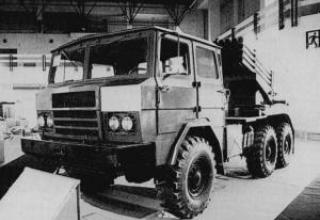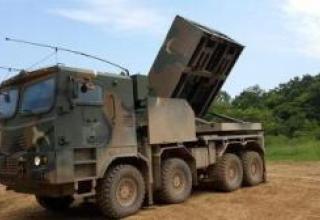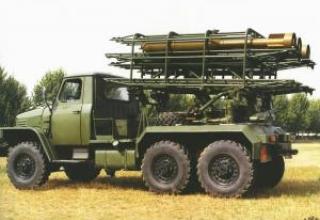The DP-62 "Dam" complex is designed to defeat submarine sabotage forces and means of the enemy in the form of ultra-small submarines and submarine saboteurs in order to provide anti-sabotage defense at the entrances to the docking and basing points of ships, as well as to protect the operational areas of the maritime state border.
The main developer of the Damba complex is TulGosNIITochMash (now NPO SPLAV (Tula). "The "Dam" self-propelled coastal bombshell jet complex was developed on the basis of Resolution of the Council of Ministers of the USSR No.999-362 of December 31, 1969 (Order of the Ministry of Foreign Affairs No.33 of January 21, 1970). During the development of the complex the experience of creating multiple launch rocket systems for ground forces such as "Grad" and "Grad-1" was used. The development of the DP-62 "Dam" complex was completed in 1980. By order of the Minister of Defence of the USSR at number 0257, the "Dyamba" complex was adopted for service with the USSR Navy. Production of combat and transport vehicles included in the complex was organized at the "Motovilikha plants" (Perm).
Export delivery of the "Dam" complex is permitted by the Decree of the President of the Russian Federation No 8S4 dated 25.07.98. The "Dyamba" complex was given the name "Dyamba Coastal Self-propelled Rocket Bombing Complex" in the export package. (DP-62E cipher). The difference between the complex elements intended for export delivery and those used in the Russian Navy is established by the documentation defining the export performance.
Composition:
Complete set of shore-based self-propelled bombshell jet complex DP-62E:
- A 122mm Unmanned Rocket Launcher-60;
- BM-21PD combat vehicle;
- ZIL-131 transport vehicle with a unified set of racks 9F37M;
- A set of technological equipment 95TO;
- Set of operational documentation
The complex works in conjunction with a hydroacoustic station, which is part of the coastal defense system or in an autonomous mode. The complex is highly mobile.
The PRS-60 unguided warhead (see the scheme) is designed to engage submarine sabotage forces and means of subversion by exploding a high-explosive warhead at a given depth of 3 to 200 meters. The high-explosive combat unit is equipped with a 20 kg explosive charge. Thanks to the cup-shaped head end, the PRS-60 projectile provides riceless firing over the entire range of ranges from 300 m to 5 km. The PRS-60 projectile is delivered in a complete set with a 95V fuse (the developer of State Unitary Enterprise Research Institute "Search", St. Petersburg). By agreement with the Customer 122 mm uncontrollable practical rocket projectile PrS-60UT with inert head part and dimensions and mass layout of the fuse, which is used for training firing, is additionally delivered.
The BM-21PD combat vehicle is designed to provide firing of projectiles from 40 guides by single launches, partial and full salvo. The BM-21PD combat vehicle is made on the chassis of the Ural-375D (Ural-4320) cross-country vehicle, is unified with the BM-21 RSZO Grad and is equipped with a rectifier unit with a filter. Thus, electric drives BM-21PD can operate both from its own power supply station, and with the help of a rectifier unit from the industrial network voltage 380V and current frequency 50Hz. Launch control is possible from the combat vehicle cabin or from a shelter. The combat vehicle is equipped with a single MAL; the delivery and composition of the group and repair MAL is specified in the contract.
The Transport Vehicle (TM) with the unified 9F37M racking set (2 racks of 20 rounds each) is designed to transport rounds, deliver them to the combat vehicle, and, if necessary, store them in racks, and transport boxes of fuses. A modified chassis of ZIL-131 truck was used as a base.
The set of technological equipment 95TO is designed for routine work with shells in the process of their storage at bases and arsenals. The set of training means is used for education and training of personnel.
Characteristics:
| ORS-60 projectile caliber, mm | 122 |
| The length of the projectile ORS-60, mm | 2745 |
| Weight of projectile ORS-60, kg | 75.3 |
| Mass of explosive in the head of projectile ORS-60, kg | 20 |
| Range of fire, m: - maximum - minimum |
5000 300 |
| Depth of combat use, m | 3-200 |
| Probability of hitting a submarine saboteur with half a salvo (20 shells). | 0.99 |
| Full salvo time, sec | 20 |
| Temperature range of projectile warfare, ° C | between -40 and +50 |
| Number of BM guides, pcs. | 40 |
| Weight of BM, loaded with 40 shells and calculated, kg | 14260 |
| The calculation of BM, man. | 3 |
| Maximum speed BM, km/h. | 75 |
| Maximum ford depth to be overcome, m | 1.5 |
| Weight of the transport machine, kg | 9500 |
| Number of shells carried by TM | 40 |
| Number of transported fuses on TM | 40 |
Testing:
Experimental and design work on the creation of the "Dam" complex was carried out on the basis of the USSR Council of Ministers Decree of December 31, 1969 № 999-362 (Order of the Minister of Mechanical Engineering of January 22, 1970 № 23 on the tactical and technical task of 62758 with the deadline for submission for state testing in the second quarter of 1972.
At the testing stage, as a combat vehicle of the self-propelled shore-based jet bomb of the "Dam" complex was used a regular combat vehicle BM-21 system "Grad", modified to reduce the force of locking force, as well as its re-equipment converter to provide power supply to electrical equipment (guidance of the launcher) from the industrial power grid.
Experience of development of "Dam" complex has shown impossibility in short term (according to the plan the term of 3 months was established) to perform works on updating and reissue of the documentation by results of factory tests and to make on it the state party. Usually it required at least 9-12 months.
By results of performance of works by the sketch design (June, 1971) the complex has been recommended on factory testing (the conclusion in part 62758, out. № 715/003803 from 09.09.1971).
The factory development should have been confirmed by the results of the following tests:
- 15 poster bombings of combat units;
- 99 rocket engine bench tests;
- 500 launches of projectiles from a combat vehicle, of which 400 launches at the Institute "Geodesy" and 100 launches in 78384.
As part of the factory development work, various types of them were entrusted:
- Chapaevsky Chemical Plant - filling combat units with explosives.
- Institute "Geodesy" - carrying out flight tests.
- Perm Machine-Building Plant named after V.I. Lenin - delivery of two combat vehicles BM-21PD: one to the Institute "Geodesy" and the second in 78384.
- Research Institute "Search" - detonators 95VZ.
- Leningrad Research Institute of Chemical Instrument Engineering - protected pyropatroons PP-9RS-3N.
As of March 15, 1972, the factory development could be completed by June 15, 1972.
In 1984, Vanin Evgeny Sergeevich for his work on the topic: "Ammunition to the self-propelled shore-based jet complex "Dam" (work presented by NPO SPLAV was awarded the prize named after S.I. Mosin. He was directly involved in the development of the "Dyamba" complex and the ammunition for its ORS-60.
Sources:
- ОТЧЕТНЫЙ ДОКЛАД о работе Тульского Государственного научно-исследовательского института точного машиностроения за 1971 год / РАБОТЫ ПО РЕАКТИВНЫМ СИСТЕМАМ ЗАЛПОВОГО ОГНЯ, РАКЕТНЫМ КОМПЛЕКСАМ И НЕУПРАВЛЯЕМЫМ РЕАКТИВНЫМ СНАРЯДАМ К НИМ / Самоходный береговой реактивный бомбометный комплекс “Дамба” (тема КВ2-003-70). Январь 1972 г. 20.I.72г. // ГУ “ГАТО”. Ф. 1. Д. 1104. Л. 8,21,110об.
- ГУ "ГАТО" (бывшее ГКУ "ГАТО" и ГАУ ТО "ГА"). Ф. Р-3428. Оп. 1. Д. 1193. Л. 54.
- С П Р А В К А по опытно-конструкторским работам по темам “Дамба”, “Удав-I”, “Пауза”, “Дамба”, “Огонь” и “Заслон”. / САМОХОДНЫЙ БЕРЕГОВОЙ БОМБОМЕТНЫЙ КОМПЛЕКС (шифр “Дамба”) от руки дописано Тема КВ2-003-70. Подписал Заместитель директора по научной работе А.Ганичев. I5.Ш.72г. // ГУ “ГАТО”. Ф. Р-3428. Оп. 1. Д. 1194. Л. 25,26,27,32,32об.
- ОТЧЕТНЫЙ ДОКЛАД о работе Тульского Государственного научно-исследовательского института точного машиностроения за 1971 год / РАБОТЫ ПО РЕАКТИВНЫМ СИСТЕМАМ ЗАЛПОВОГО ОГНЯ, РАКЕТНЫМ КОМПЛЕКСАМ И НЕУПРАВЛЯЕМЫМ РЕАКТИВНЫМ СНАРЯДАМ К НИМ / Самоходный береговой реактивный бомбометный комплекс “Дамба” (тема КВ2-003-70). Январь 1972 г. 20.I.72г. // ГУ “ГАТО”. Ф. 1. Д. 1104. Л. 8,21,110об.
- Письмо. г. Тула, № 3347с/I77 5 04 72 объема работ в денежном выражении для ВМФ Командиру в.ч. 62758 тов. ПУХОВУ А.Г., Г. Москва, К-I75. Подписал Заместитель директора по научной работе А.Ганичев за директора В. Рогожина. Согласовал Представитель заказчика С. Кожевников 03.4.72. 30.Ш.72г. Подлинник // ГУ “ГАТО”. Ф. Р-3428. Оп. 1. Д. 1194. Л. 48,49.
- Письмо на фирменном бланке из Предприятия почтовый ящик № В-8921 I94I95 № З-3848с отп. 30 V 1972 г На Ваш № 03828сс/I77 от 29 04 I972г Предприятие п/я Г-4575 г. Тула Копия ВОИНСКАЯ ЧАСТЬ 3i303-7 г. Ленинград По вопросу: плана-графика работ по теме "Удав-I". Подписал руководитель Еньков (вместо зам. руководителя Симоняна) 26.05.72. I9/У-72. Подлинник // ГУ “ГАТО”. Ф. 1. Д. 1104. Л. 100,101.
- Премия имени С.И. Мосина: из века в век. – М.: Издательский дом «Оружие и технологии», 2018. – С. 189.
- Рекламный паспорт №6894/00/НЭК на Противодиверсионный самоходный береговой реактивный комплекс ДП-62 “Дамба”. Перерегистрирован: 02.09.2004 г.– С. 3. Копия.
- Паспорт экспортного облика №5941/99/НЭК на Противодиверсионный самоходный береговой реактивный комплекс ДП-62 “Дамба”. Перерегистрирован: 02.09.2004 г.– С. 6. Копия.
- Люди, годы, залпы. 60 лет ФГУП “ГНПП “Сплав”/ ФГУП “ГНПП “Сплав”: составитель Е.М. Мартынов, под редакцией Н.А. Макаровца; ред коллегия: Г.А. Денежкин, Р.А. Кобылин, Г.И. Блинов. – Тула: ОАО “Тульская типография”, 2009. – С.8.
- СТРЕЛЬБЫ СПЕЦИАЛЬНОГО НАЗНАЧЕНИЯ /Тихоокеанский флот ВМФ России/ФГУП «ГНПП «Сплав» - Снаряд комплекса «Дамба»
- ФГУП «ГНПП «Сплав» - Боевая машина БМ-21ПД
